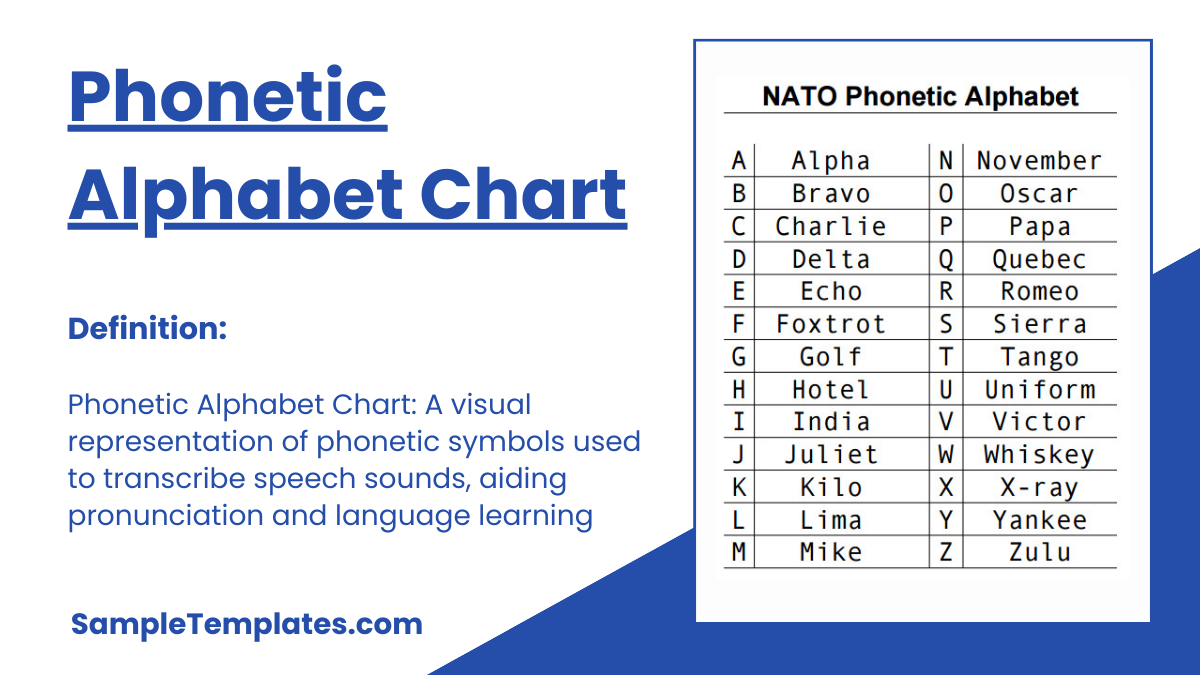An alphabet that has an assigned name to each of the letters can be learned from a well documented phonetic alphabet ABC Chart Template. The system is immensely used in military, police and many other emergency services. For example, to say “with” while using these Chart Templates one would say “Whiskey-India-Tango-Hotel”.
Using this phonetic alphabet is very useful for computer support and on a phone call where one needs to spell out what is being said properly or needs to be typed after listening over telephone. NATO phonetic alphabet is quite commonly used all over the world as a phonetic guidance for English alphabets.
NATO Phonetic Alphabet Chart
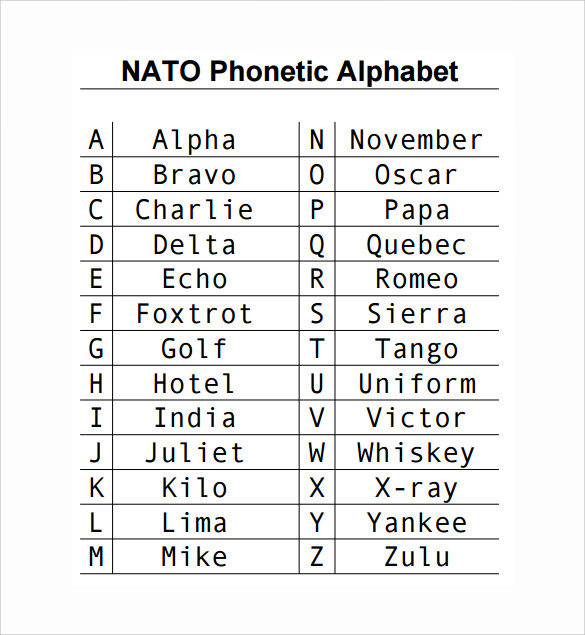
This is an alphabetical chart that contains all the alphabets of English language, and an assigned word to each alphabet. Army and military personnel frequently use this chart for talking or writing in code words, so that others cannot understand what they are saying.
Phonetic Alphabets Reference Chart
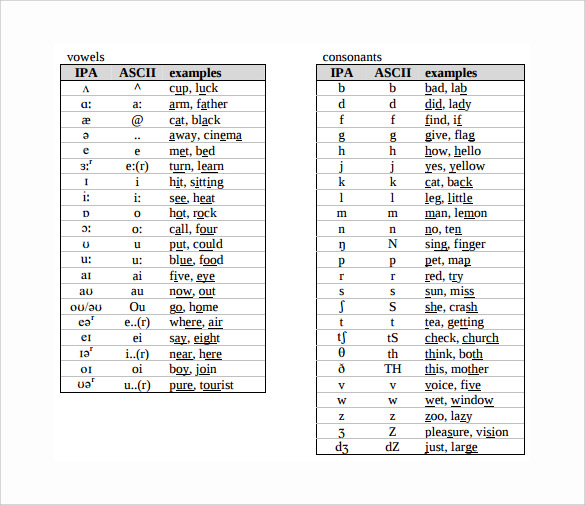
This is more of an educational kind of phonetic alphabets chart. It has different tables for vowels and consonants, with IPA and ASCII for each phonetic sound, along with a couple of example words for each. With this reference chart, you can better know how to pronounce alphabets in different settings.
English Phonetic Alphabet Chart
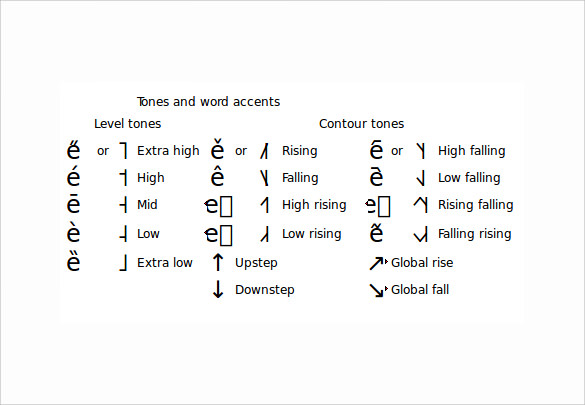
This is a phonetic alphabet chart with which you can denote each alphabet’s pronunciation with the help of signs and symbols. It mentions the tones and word accents, along with the level tones and contour tones for each. This chart is extremely helpful in understanding phonetic structure of different consonants and vowels.
Tips For Using the Phonetic Alphabet Chart
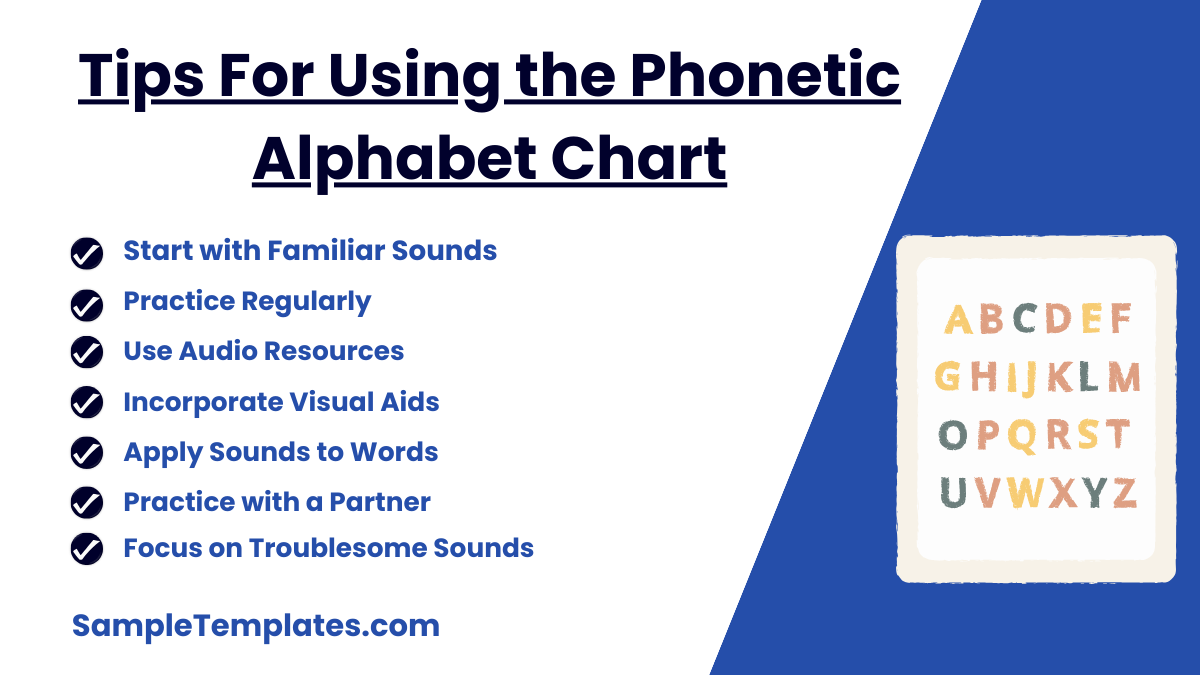
Using the Phonetic Alphabet Chart effectively can greatly enhance language learning, pronunciation, and communication skills. Here are some tips for maximizing its benefits:
- Start with Familiar Sounds: Begin by identifying sounds in the chart that exist in your native language. This will help you get comfortable with using the simple chart.
- Practice Regularly: Regular practice with the chart can improve your pronunciation skills over time. Try to dedicate a few minutes each day to this practice.
- Use Audio Resources: Listening to the pronunciation of phonetic sounds while looking at the chart can help you understand the nuances of each sound more clearly.
- Incorporate Visual Aids: Visual aids, such as mouth position diagrams or videos, can complement the phonetic chart by showing how to produce each sound physically.
- Apply Sounds to Words: Practice applying the phonetic sounds to words you know. This application can help solidify your understanding and improve your pronunciation.
- Practice with a Partner: Practicing with someone else can provide immediate sample feedback and make the learning process more interactive and fun.
- Focus on Troublesome Sounds: Identify sounds that are particularly challenging for you and focus your practice on these areas. Over time, this targeted practice can lead to significant improvements.
- Utilize Online Tools and Apps: Many online resources and apps offer interactive ways to learn phonetic sounds using the chart. These tools can provide additional practice and reinforcement.
- Integrate into Language Learning: If you are learning a new language, use the phonetic chart as a reference to master the pronunciation of difficult or unfamiliar sounds.
- Be Patient and Persistent: Learning to accurately produce and recognize the sounds in the phonetic alphabet takes time and practice. Be patient with yourself and persist through the challenges.
By following these tips and incorporating the Phonetic Alphabet Chart into your language learning or teaching strategy, you can significantly enhance your or your students’ ability to communicate effectively in another language.
Sample Phonetic Chart

This is another phonetic chart with English language alphabets, and a word assigned to each alphabet. The assigned word is used in place of each alphabet. The sentence that you speak with the use of these words cannot be understood by anyone else, other than those who remember this phonetic chart.
International Phonetic Alphabet Symbols Chart
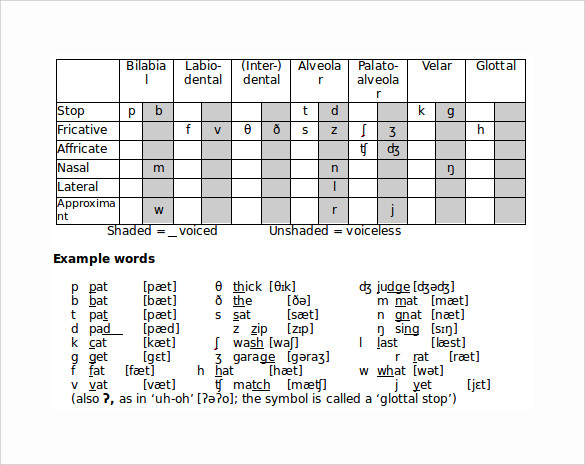
Military Phonetic Alphabet Chart
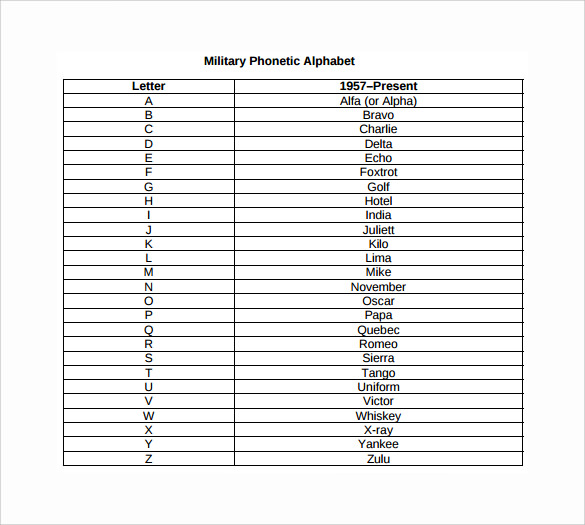
International Phonetic Alphabet Chart
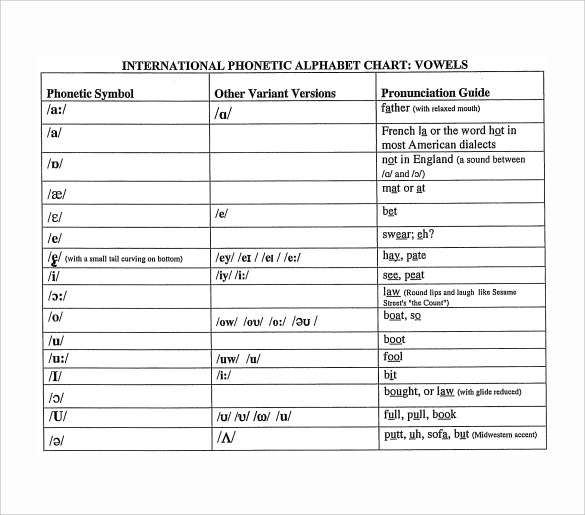
Why Do You Need a Sample Phonetic Alphabet Chart Template?
A phonetic alphabet chart template can be interesting learning equipment for those who want to learn or teach English in spoken form. If you frequently need to check pronunciations of words in a dictionary, then you can maintain a phonetic alphabet chart to make things easier and faster for you.
A phonetic alphabet chart template can be an effective tool that can help you learn sounds of the English language. With a phonetic alphabet chart, you can also do a quiz to check how well you know and where you need to improve. You may like Phonics Alphabet Charts.
Benefits of Phonetic Alphabet Chart
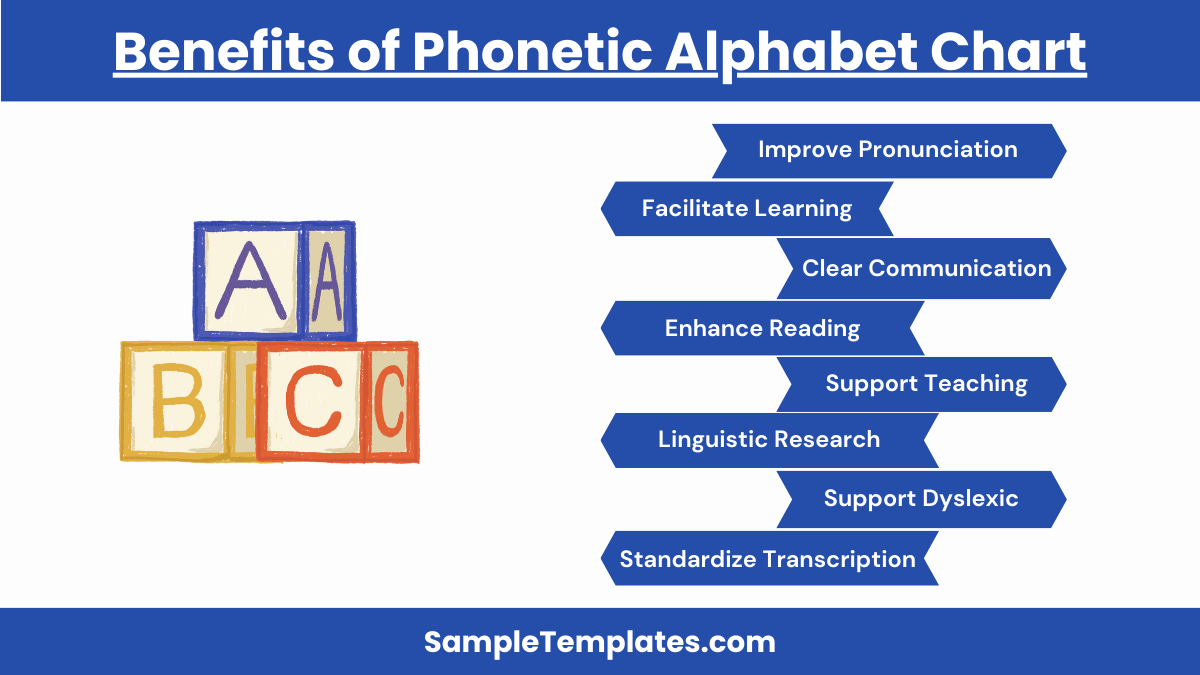
The Phonetic Alphabet Chart is an essential tool with numerous benefits for language learning, communication, and education. Here are some key advantages:
- Improves Pronunciation: It helps learners and speakers of a language understand and practice the correct pronunciation of words, minimizing errors and accent issues.
- Facilitates Language Learning: By providing a visual representation of sounds, the chart makes it easier for learners to grasp the nuances of a new language, speeding up the learning process.
- Aids in Clear Communication: In fields such as aviation, military, and emergency services, the phonetic alphabet ensures clear and unambiguous communication, crucial in high-stakes environments.
- Enhances Reading Skills: It supports reading and literacy by helping learners decode words phonetically, improving their ability to read unfamiliar words.
- Supports Language Teaching: Educators can use the printable chart as a teaching aid to explain phonetic concepts, helping students understand sound patterns and spelling rules.
- Useful for Linguistic Research: Linguists and researchers use the phonetic alphabet to transcribe languages accurately, facilitating the study of language structures and speech patterns.
- Assists in Speech Therapy: Speech therapists use phonetic symbols to diagnose and treat speech disorders, helping individuals articulate sounds correctly.
- Promotes Internationalization: The chart helps non-native speakers pronounce names, places, and technical terms more accurately, promoting better international communication and understanding.
- Standardizes Transcription: It provides a standardized method for transcribing sounds, ensuring consistency across different languages and dialects.
- Supports Dyslexic Learners: Phonetic charts can aid dyslexic students by providing alternative strategies for reading and spelling, based on sound rather than memory.
Overall, the Phonetic Alphabet Chart is a versatile and powerful tool that enhances linguistic competence, communication, and educational outcomes across various contexts.
What is phonetic alphabet for kids?
The phonetic alphabet for kids is a simplified version designed to teach children the basic sounds of simple letters in the English language, aiding in early reading and spelling skills.
What is the full phonetic alphabet?
The full phonetic alphabet, or the International Phonetic Alphabet (IPA), is a comprehensive system for transcribing the sounds of spoken languages, including all vowels, consonants, and intonations.
What is phonetics code?
Phonetic code refers to the system used in phonetics to represent the sounds of speech with symbols, allowing for accurate transcription and study of different languages and dialects.
How many phonetic alphabets are there?
There is one main phonetic alphabet, the International Phonetic Alphabet (IPA), which is used worldwide. However, variations and simplified versions exist for specific educational purposes or languages.
What is phonetic alphabet for kids?
The phonetic alphabet for kids is a tool to help children understand the sounds that correspond to letters and letter combinations, making learning to read and write more intuitive.
In conclusion, the Phonetic Alphabet Chart serves as a vital communication tool, enhancing clarity and precision in verbal exchanges. Its systematic representation of sounds enables effective transmission of information, particularly in critical situations. Embracing and mastering this tool empowers individuals across diverse fields, fostering seamless and accurate communication.
If you have any DMCA issues on this post, please contact us!
Related Posts
Weekly Schedule Samples & Templates
Contractual Agreement Samples & Templates
FREE 9+ Amazing Sample Church Bulletin Templates in PSD | PDF
Sample Business Card Templates
Sample Cashier Job Descriptions
Questionnaire Samples
FREE 10+ Sample HR Resource Templates in PDF
FREE 10+ HR Consulting Business Plan Samples in MS Word | Google Docs | Pages | PDF
FREE 49+ Sample Job Descriptions in PDF | MS Word
FREE 16+ Nonprofit Budget Samples in PDF | MS Word | Excel | Google Docs | Google Sheets | Numbers | Pages
FREE 13+ Academic Calendar Templates in Google Docs | MS Word | Pages | PDF
FREE 10+ How to Create an Executive Summary Samples in Google Docs | MS Word | Pages | PDF
FREE 23+ Sample Event Calendar Templates in PDF | MS Word | Google Docs | Apple Pages
Company Profile Samples
FREE 10+ Leadership Report Samples [ Development, Training, Camp ]
